
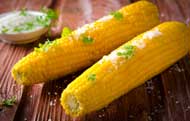
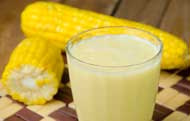

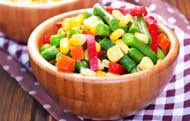

|
1. Sweet Corn Facts
|
|
2. Types of Sweet Corn (Australia)
|
|
3. Sweet Corn Nutritional Value
|
|
4. Sweet Corn Health Benefits
|
Sweet corn is a variety of maize with a high sugar content. Unlike field corn varieties, which are harvested when the kernels are dry and mature (dent stage), sweet corn must be picked when immature (milk stage) and prepared and eaten as a vegetable, rather than a grain. Since the process of maturation involves converting sugar to starch, sweet corn stores poorly and must be eaten fresh, canned, or frozen, before the kernels become tough and starchy.
History and Origin
It is believed that sweet corn was first domesticated between 9,000 and 8,000 BC and by 2,000 to 1,500 BC it had become a staple food or regularly consumed by the Olmecs and Mayans. It is believed that they held it in such high regard, that it became part of their daily rituals and took on religious significance. It also featured in their art. Ears of corn have been found in caves in Mexico which date back to around 5000-6000 BC.
Sweet corn or corn on the cob is a variant of Zea mays, Zea mays var nigosa or Zea saccharata (meaning sugary). It originated in what is now Mexico and Central America, from a wild grass, which was crossed with teosinte (another wild grass), but the original ancestor no longer exists. Zea mays is the original corn that was grown by the tribes of Central America and Mexico, the Aztecs, Mayans and Olmecs and can be yellow, white, purple, red, brown and even have multi-coloured kernels.
The Spaniards came across corn in the 15th century and too it back to Spain in the 16th century. By 1575 corn had been introduced into the Philippines, Indonesia, and western China. It was also taken to Africa where it has become a staple food. It was useful in that continent during the years of the slave trade, as although people were transported to the colonies in the New World, corn helped the population to grow rather than to diminish from illnesses such as malnutrition and because of the fact that so many people were transported.
- • Jubilee
- • .Terrific
- • .
- • .
- • Honey Sweet
- • Goldensweet
- • Goldensweet Improved
- • Dynasty
- • Gladiator
- • Punchline
- • Sovereign
- • Matador
- • Golden Pearl
- • Crunch
- • Samurai
- • Madonna
- • Everest
- • Blizzard
Normal Corn
Is the type of corn traditionally grown in the past such as Jubilee. It differs from maize by having genes which slow down the conversion of sugar into starch and characteristically has a creamy texture when ripe. The main normal variety is Jubilee.
Supersweet Corn
Nearly all corn grown for fresh market are supersweet types. These types differ from the traditional normal type for they have a shrunken gene which produces twice the level of sugar as in normal varieties and also reduces further the rate of sugar conversion to starch. The result is a very sweet cob and supersweets are now the major type of sweet corn sold on the fresh market.
Supersweets are also available in bi-colour forms which have white kernels dotted amongst the yellow kernels which give them a more distinctive appearance from the traditional normal types.
New cultivars are constantly being released and the main varieties grown will continue to change. Cultivars differ considerably in characteristics such as length of growing season, cob number, cob size and number of kernel rows per cob. The depth, colour and flavour are also cultivator characteristics.
Vegetables " Sweet Corn "
Nutritional value per 100 g
Corn, sweet, yellow, cooked, boiled, drained, without salt
|
Nutrient ( Proximate's )
|
Unit
|
Value
|
Daily Value %
|
|
Energy
|
kcal
|
96 | 4.8% |
|
Protein
|
g
|
3.41 | 6.8% |
|
Total lipid (fat)
|
g
|
1.50 | 1.9% |
|
Carbohydrate, by difference
|
g
|
21 | 7.6% |
|
Fiber, total dietary
|
g
|
2.4 | 8.5% |
|
Sugars, total
|
g
|
4.54
|
|
|
Minerals
|
|||
|
Calcium, Ca
|
mg
|
3 | 0.2% |
|
Iron, Fe
|
mg
|
0.45 | 2.5% |
|
Magnesium, Mg
|
mg
|
26 | 6.1% |
|
Phosphorus, P
|
mg
|
77 | 6.1% |
|
Potassium, K
|
mg
|
218 | 4.6% |
|
Sodium, Na
|
mg
|
1 | 00.4% |
|
Zinc, Zn
|
mg
|
0.62 | 5.6% |
|
Copper, Cu
|
mg
|
0.049 | 5.4% |
|
Manganese, Mn
|
mg
|
0.167 | 7.2% |
|
Selenium, Se
|
mcg
|
0.2 | 0.3% |
|
Vitamins
|
|||
|
Vitamin C, total ascorbic acid
|
mg
|
5.5 | 6.1% |
|
Thiamin (B-1)
|
mg
|
0.093 | 7.7% |
|
Riboflavin (B-2)
|
mg
|
0.057 | 4.3% |
|
Niacin (B-3)
|
mg
|
1.683 | 10.5% |
|
Pantothenic acid (B-5)
|
mg
|
0.792 | 15.8% |
|
Vitamin B-6
|
mg
|
0.139 | 8.1% |
|
Folate, total (B-9)
|
mcg
|
23 | 5.7% |
|
Vitamin B-12
|
mcg
|
0.00
|
|
|
Vitamin A, RAE
|
mcg
|
13 | 1.4% |
|
Vitamin E (alpha-tocopherol)
|
mg
|
0.09 | 0.6% |
|
Vitamin D (D2 + D3)
|
mcg
|
0
|
|
|
Vitamin K (phylloquinone)
|
mcg
|
0.4 | 0.3% |
|
Lipids
|
|||
|
Saturated Fatty Acids
|
g
|
0.197
|
0.9% |
|
Monounsaturated Fatty Acids
|
g
|
0.374
|
|
|
Polyunsaturated Fatty Acids
|
g
|
0.603
|
|
|
Trans Fatty Acids
|
g
|
0.000
|
|
|
Carotenoids
|
|||
|
Beta-Carotene
|
mcg
|
66
|
|
|
Alpha-Carotene
|
mcg
|
||
|
Beta-Cryptoxanthin
|
mcg
|
||
|
Lutein + zeaxanthin
|
mcg
|
906
|
|
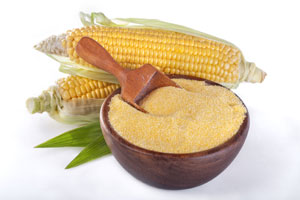
|
Reference Values are based on a 2,000 Calorie Intake, for Adults and Children 4 or More Years of Age. Your daily values may be higher or lower depending on your calorie needs.
|
|
Percentages are roughly approximated using (RDA) Recommended Dietary Allowances for adults. Source: USDA United States Department of Agriculture
|
|
Reference Values for Nutrition - FDA U.S. Food and Drug Administration
|
Sweet Corn Nutritional Value
This vegetable, although being sweet and delicious, is a great source or many vitamins and minerals.
Sweet corn is one of the most popular vegetables. It is loved by adults and children alike because of its sweet flavour. This vegetable, although being sweet and delicious, is a great source or many vitamins and minerals.
Sweet corn is very rich in vitamin B1, vitamin B5, vitamin C, phosphorus, manganese, folate and dietary fiber.
Because of the vitamins contained in sweet corn, many health benefits can be associated with the consumption of this delicious vegetable.
It is an excellent source of folate. Consumption of folate is effective in lowering the homocysteine levels in the body. Homocysteine is an amino acid that can damage the blood vessels. Elevated levels of homocysteine in the body can directly lead to heart attacks, strokes and peripheral vascular disease. Sweet corn also contains a chemical known as beta cryptoxanthin. The human body converts beta cryptoxanthin to vitamin A when consumed in foods.
Cancer Prevention - Several cohort studies have suggested the greater amount of beta cryptoxanthin that is consumed, the lower the prevalence of lung cancer development.
Sweet corn contains high levels of thiamine, or vitamin B1. Consumption of thiamine is necessary for the body to produce acetylcholine. Acetylcholine is a neurotransmitter that is essential for the maintenance of memory capabilities. One of the primary factors associated with Alzheimer's disease is low levels of acetylcholine.
Sweet corn contains the antioxidant zeaxanthin. Zeaxanthin is the yellow pigment that naturally occurs in sweet corn. Consumption of zeaxanthin can have a protective effect against age-related eye diseases such as macular degeneration. In addition, sweet corn also contains folate and beta carotene, which also may protect against macular degeneration.
- BLOOD SUGAR BENEFITS (Fiber, vitamins B1, B5 and folic acid)
- LONG LASTING ENERGY (Slowly digested carbohydrate)
- CONTROLS DIABETES AND HYPERTENSION (Mellitus and phenolic phytochemicals)
- MEMORY AND ALZHEIMERS (High levels of thiamine)
- LOWERS LUNG CANCER DEVELOPMENT (Vitamin A)
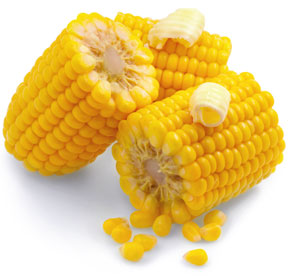
- DIGESTIVE BENEFITS (Excellent source of dietary fibre)
- STRONGER CONNECTIVE TISSUE (Manganese)
- HEART ATTACTS - STROKE (Excellent source of folate)
- ANTIOXIDANT BENEFITS (Many Antioxidant Phytonutrients)
- AGE RELATED EYE DISEASES (Zeaxanthin and lutein)
References
|
Nutrient Database - USDA (United States Department of Agriculture)
|
|
Reference Values for Nutrition - FDA U.S. Food and Drug Administration
|
For More Information
Sweet Corn - From Wikipedia, the free encyclopedia
